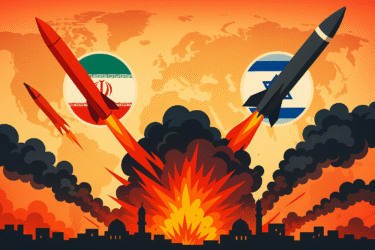What started as a cold war between Israel and Iran transformed into a direct confrontation between 2024 and 2025. The war has reshaped the geopolitics of the world, particularly the Middle East. Fear of further escalation in the region is in the air. Let’s discuss key turning points in the conflict, starting from the embassy strike in Damascus to the attack on Iran’s nuclear sites in 2025. We will discuss what happened on the ground, how the communities on the ground were affected, and what it means for the future of the region.

Phase-I: The Damascus Embassy Strike (April 1, 2024)
The Catalyst
On April 1, 2024, Israel carried out air strikes on Iran’s consular annex in Damascus. As a result, 16 people, including Iran’s Quds Force Commander Mohammad Reza Zahedi along with his deputy, were killed. The attack marked the start of a direct confrontation between Iran and Israel. Iran called the attack an “act of terrorism” under the UN convention, while Israel justified the attacks as eliminating architects of imminent attacks. Israel’s strategic calculation for the attack was that it would hit Iran’s regional command structure while it was already busy fighting Hamas since the October 7 attack. Following the strike, pressure mounted on Khamenei’s administration to avenge the killing of their leaders. Iran vowed to punish the Zionist regime.
Phase-2: Iran’s Unprecedented Direct Attack (April 13-14, 2024)
Operation True Promise
On April 13, 2024, Iran carried out its first strike on Israel with 300 drones and missiles. According to different reports, it included more than 170 Shahed-136 loitering munitions, more than 30 cruise missiles, and around 120 ballistic missiles. Israel was defended on multilateral fronts. The USA, UK, France, and Jordan reportedly intercepted 95% of the projectiles. For instance, Jordan intercepted drones in its airspace. Similarly, Israeli Arrow-3 systems destroyed ballistic missiles. The Nevatim Airbase was also damaged during Iran’s strike. The strike showed Iran’s capability to carry out strikes and Israel’s integrated defense.
Phase-3: Israel’s Retaliation (April 19, 2024)
The Isfahan Strike
Six days after Iran’s strike, on April 19, 2024, Israel carried out strikes on an air defense radar site near Isfahan. The site was protecting the Natanz nuclear facility. The strike included drones and missiles; however, it caused little damage. Following Israel’s strike, US pressure prevented a wider conflict, and both countries signaled to avoid an all-out war.
The Simmering Proxy War (May 2024 – May 2025)
Despite the fact that a wider conflict was avoided, Israel continued its attacks against Iran or its related targets in the region. On July 31, 2024, Ismail Haniyeh, Hamas Political Chief, was assassinated in Tehran. Similarly, Hassan Nasrallah, a Hezbollah leader, was killed in a Beirut airstrike on September 27, 2024. On October 16, 2024, Hamas Gaza leader Yahya Sinwar was killed. Reportedly, Hezbollah has lost most of its rocket arsenal in different Israeli airstrikes. Hamas’ military capabilities have also decreased.
Operation True Promise-II and Tit-for-Tat Exchanges
Following the above targeted killings, Iran could not remain silent. On October 1, 2024, Iran reportedly carried out 200+ missile strikes on Israel. As retaliation for these missile strikes, Israel targeted Iran’s missile sites on October 26, 2024.
Phase 4: Operation Rising Lion – The Nuclear Gambit (June 12-15, 2025)
On June 12, 2025, Israel started Operation Rising Lion. Israel launched air strikes targeting Iran’s nuclear and military infrastructure. For instance, the Natanz enrichment complex and the Fordow underground facility were targeted. Similarly, IRGC command centers in Tehran’s Lavizan district and Shahran, as well as the Shahr Rey oil refineries, were targeted by Israel. During these strikes, IRGC commander Hossein Salami, Armed Forces Chief of Staff Mohammad Bagheri, and nuclear scientists Fereydoon Abbasi and Mohammad Mehdi Tehranchi were killed in these strikes.
Operation True Promise-III
Following Israel’s strikes, on June 13, 2025, Iran launched missiles and targeted Israeli military targets. Similarly, Iran targeted Israel’s Haifa port on June 14 and, the next day, targeted the Tamra area of Israel.
Humanitarian Toll
(below figures can vary, as it has been taken from different online sources)
Iran: 224+ dead, 1481+ wounded from Israeli strikes
Israel: 13+ dead, 380+ wounded from Iranian attacks
Displacement: 40,000+ Palestinians displaced in West Bank buffer zones
Economic and Logistical Impacts
Due to the ongoing war, Iran’s oil production has been partially suspended at the South Pars field. Similarly, Israeli and Iranian airspaces are closed for an indefinite period. El Al Airlines has canceled flights to 20+ destinations until 2025. It is pertinent to mention that it is really difficult to ascertain the actual extent of economic and logistical impact during the ongoing war. Final details would be available as soon as the war is over, and numbers are released by both countries.
Diplomatic Deadlock
Soon after the start of the war, US-Iran nuclear negotiations in Oman were suspended, putting an end to all the recent efforts made by the US and Biden’s administration. Similarly, an emergency summit of the G7 was convened, which did not result in any positive outcome. Efforts are afoot in the United Nations to condemn Israel’s strikes and stop the war.
Geopolitical Implications
The ongoing war between Israel and Iran has severe geopolitical implications for not only the region but also for the world. After Israel began its fight against Hamas, it also began targeting Hezbollah, a key ally of Iran. Following the strikes of June 12, it is assessed that Hezbollah’s capabilities have been diminished to a certain point so that it could not help Iran openly. Similarly, there is also an issue of missile deficiencies in Iran in the long term.
As the war drags on, it could create pressure not only on Israel and Iran. In Iran, this could be reflected in the form of protests by locals who are already under pressure due to a weak economy. Succession struggles could also be observed after the killing of Iran’s senior commanders. In this scenario, the whole game would be left to the partners in the war.
Moreover, despite the fact that Israel has conducted air strikes on Iran’s nuclear facilities, experts assess that Iran still has the capability to make a nuclear bomb in the near future. The only thing that can halt Iran’s uranium enrichment is renewed nuclear dialogue by relevant stakeholders.
The Road Ahead: Four Potential Scenarios
- Protracted Air War (60% likelihood): There is a major chance of continued tit-for-tat strikes below the all-out war threshold. Geographical restraint could be a major factor in the continuation of such strikes.
- Diplomatic Off-Ramp (20%): China has already started making diplomatic calls to both Israel and Iran for a ceasefire. Similarly, a UN, G7-brokered ceasefire could also be a potential outcome in the next days.
- Regional Conflagration (15%): There is a grave danger of conflict spilling into the region, particularly into Lebanon / Syria, drawing Gulf States into the conflict.
- Regime Change Gambit (5%): Another possibility is that Israel, with the help of the USA, could intensify strikes along with economic sanctions to trigger an uprising which could be a threat to Tehran’s leadership.



